Why Leadership Communication Fails (Even When the Intent Is Good)

Did you know? Only 7% of employees believe workplace communication is accurate, timely, and open. Yet, 86% of workers and executives say poor communication is the top reason for workplace failures. Leadership messages often miss the mark, even with the best intentions. Why? Here’s a quick breakdown:
- Words and actions don’t align, eroding trust.
- Messages are too generic, making them feel impersonal.
- Transparency is lacking, creating disengagement.
The cost? UK and US businesses lose £29.6 billion annually due to miscommunication, while organisations with just 100 employees can lose £336,000 a year. Poor communication also impacts morale, creativity, and teamwork.
Key Solutions:
- Align words with actions to build trust.
- Use clear, simple, and tailored messages.
- Foster two-way communication with regular feedback channels.
Effective communication ties directly to company goals, boosts engagement, and improves financial performance. Let’s explore how to fix leadership communication.
Why Leadership Messages Miss Their Mark
When Words Don't Match Reality
When leaders' actions and words don't align, or when they fail to acknowledge mistakes, trust and credibility take a hit. Employees notice when there's a disconnect between what's said and what's done.
Mixed Messages and Confusion
Even when intentions are good, how messages are crafted can create confusion. Overloading employees with jargon, conflicting instructions, or too much information makes it harder to focus on what's important. This becomes even more problematic during periods of organisational change.
One-Way Communication Traps
Another common issue is the delivery method. Many leaders rely on a top-down, one-way approach, where messages are broadcasted without room for feedback. This can leave employees feeling ignored, and important insights from the frontlines never make it back to leadership. When leaders assume their message is clear or let their position create a barrier, genuine dialogue suffers. Here's a comparison of how one-way and two-way communication differ:
| Communication Element | Traditional One-Way | Effective Two-Way |
|---|---|---|
| Feedback Channels | Annual surveys only | Regular check-ins and open forums |
| Message Delivery | Mass emails and announcements | Tailored communication by team |
| Employee Input | Limited or none | Active solicitation of ideas |
| Follow-up | Minimal | Consistent clarification and adjustment |
These gaps in communication highlight the need for better approaches, which will be explored in the next section.
The Cost of Poor Leadership Communication
Poor communication in leadership doesn't just lower morale - it can significantly impact the organisation's bottom line.
Lost Trust and Team Turnover
When communication breaks down, employee trust takes a hit, leading to higher absenteeism and turnover rates. In the UK and US, businesses lose a staggering £29.6 billion annually due to miscommunication alone.
Business Impact and Lost Revenue
The financial repercussions of poor communication are massive. Research involving 400 large companies revealed that miscommunication costs them an average of £49.9 million each year. Smaller organisations aren't immune either - companies with just 100 employees lose around £336,000 annually due to ineffective communication.
"Building exemplary communications in a hybrid and remote setting requires a lot of clarification of expectations and goals. People are busy making assumptions about what you want, even more so than they were when you shared the same office space. And those assumptions are probably not correct. Instead, you have to do a lot more 'telling.' Be specific."
These figures highlight the urgent need to rethink communication strategies.
Reduced Teamwork and New Ideas
A lack of clear communication hampers collaboration and stifles creativity. As trust declines, teamwork suffers, and organisations miss out on valuable input from frontline employees. When leaders distance themselves from their teams, they create silos and block the flow of ideas.
"The single biggest problem in communication is the illusion that it has taken place."
This disconnect prevents teams from working together effectively, limiting knowledge sharing and innovation.
How to Fix Leadership Communication
Connect Messages to Company Goals
Strong leadership communication ties directly to the organisation's goals. Leaders should create regular opportunities for feedback to ensure their messages reflect both the company's strategy and the day-to-day realities employees face. Actively listening to team input allows leaders to craft messages that resonate with their workforce while staying aligned with broader objectives.
Write Clear, Simple Messages
Effective communication relies on three core principles:
| Principle | Description | Impact |
|---|---|---|
| Transparency | Be open about challenges and acknowledge mistakes | Builds trust and credibility |
| Consistency | Ensure actions match words and reflect organisational values | Reduces confusion and doubt |
| Specificity | Tailor messages to suit each team | Boosts relevance and engagement |
For instance, providing clear explanations for changes - expected to grow by 75% - can significantly improve engagement. Addressing potential issues early also reinforces the clarity and effectiveness of these messages.
Tools to Spot Communication Problems
Beyond crafting clear messages, identifying communication challenges early is essential. Tools like Rewired Work's Sound & Signal Review help organisations uncover systemic issues before they affect performance. These tools address concerns around trust and revenue while offering solutions for improvement.
The Leadership Communication Mastery programme focuses on building practical skills in areas such as:
- Strategic narrative creation
- Message clarity and impact
- Engaging diverse audiences
- Communicating during periods of change
With 78% of employees believing communication deserves more attention, investing in these tools can reshape how information flows within an organisation. Regularly reviewing and refining communication strategies ensures messages stay clear, relevant, and aligned with the organisation's goals.
Good vs Poor Communication Examples
The table below highlights the differences between effective and ineffective communication, using real-world examples to show their impact.
| Communication Aspect | Successful Approach | Failed Approach | Real Impact |
|---|---|---|---|
| Change Management | LeBron James announced his return to the Cleveland Cavaliers in 2011 with a thoughtful essay in Sports Illustrated. | His 2010 ESPN special "The Decision" came across as boastful and disrespectful, harming his reputation. | Shows how tone and delivery method can shape how a message is received. |
| Policy Changes | A tech CEO held monthly forums to gather employee feedback, leading to operational improvements. | Yahoo!'s 2013 memo enforcing office work used vague language, causing a drop in morale. | Emphasises the benefits of collaborative communication over top-down mandates. |
| Crisis Communication | During a system outage, an IT leader issued clear, actionable steps, reducing downtime. | UPS delayed communication during a Christmas crisis and responded dismissively, worsening the issue. | Demonstrates the need for timely and transparent communication in critical situations. |
| Technical Implementation | A manufacturing company used interactive workshops for a new inventory system, cutting down on errors. | Communication breakdowns between BP, Halliburton, and Transocean contributed to the Deepwater Horizon disaster. | Underlines the importance of clear communication in technical projects. |
These examples highlight the importance of clarity, engagement, and tone in leadership communication. They also show how effective communication can drive positive outcomes, while poor communication often results in setbacks.
"Tone is as important as content."
For instance, the manufacturing firm's workshops succeeded because they encouraged hands-on, two-way communication rather than relying on one-sided instructions. In contrast, the Deepwater Horizon incident revealed how miscommunication can lead to catastrophic consequences, as noted in the Presidential Commission's report.
In the non-profit sector, passionate speeches often inspire volunteers and staff far more than generic corporate language. Similarly, a marketing director's use of data-driven advisory sessions demonstrates how analytics-based communication can improve team performance and drive results.
"Timely, accurate, honest communication is at the heart of good customer service - and of good business practices, period."
Effective leadership communication relies on a mix of timing, tone, and transparency. When these elements come together, they build trust and improve understanding.
Next Steps for Better Communication
Research reveals that 86% of senior staff identify poor collaboration as a major failure point, while only 7% believe communication within their organisation is effective. These numbers highlight the urgent need for a structured approach to improving communication.
Strong leadership communication relies on three key elements: transparency, clarity, and consistency.
These principles form the foundation for actionable steps to enhance communication practices.
To build on these principles, consider the following:
- Define Accountability
Taking responsibility for mistakes strengthens credibility and sets a standard for openness. - Implement Regular Feedback Channels
With nearly 75% of organisations anticipating an increase in major change initiatives over the next three years, consistent feedback mechanisms can help pinpoint issues before they escalate. - Focus on Skills Development
Providing communication training can significantly improve the success rate of change initiatives, which currently stands at just 34%.
FAQs
How can leaders ensure their communication aligns with their actions to build trust within their teams?
To build trust within their teams, leaders must ensure their actions consistently match their words. This means being authentic, transparent, and honest in all communications. Misalignment between what is said and what is done can quickly erode credibility.
Leaders should also acknowledge mistakes openly and address team concerns promptly. This demonstrates accountability and fosters a culture of trust. Clear and consistent messaging, paired with genuine follow-through, helps reinforce alignment and strengthens team relationships.
How can leaders encourage effective two-way communication in an organisation?
Leaders can foster effective two-way communication by prioritising openness, clarity, and engagement. Start by creating opportunities for dialogue, such as Ask Me Anything sessions, team huddles, or focus groups, where employees feel comfortable sharing their thoughts. Regularly use a mix of communication channels, like emails, in-person meetings, or virtual chats, to ensure messages are accessible and inclusive.
Encourage feedback by asking purposeful questions and actively listening to responses. Simple initiatives, like surveys with clear objectives or informal coffee chats, can help uncover valuable insights. Always follow up on feedback to show employees that their input matters, building trust and alignment across the team.
Why is it important for leadership communication to be clear, concise, and personalised, and how does it influence organisational success?
Clear, concise, and personalised communication is vital for leadership because it fosters trust, strengthens team connections, and drives meaningful action within an organisation. When leaders communicate effectively, their messages resonate with their audience, aligning teams with organisational goals and improving overall performance.
On the other hand, vague or overly generic communication can lead to confusion, disengagement, and missed opportunities. Great leaders tailor their messages to the needs of their teams, ensuring they are practical, focused, and relevant to the audience. This approach not only inspires confidence but also enhances collaboration and productivity across the organisation.
Embedded JavaScript



